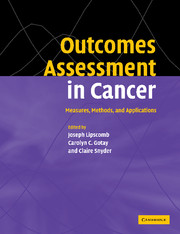Book contents
- Frontmatter
- Contents
- List of contributors
- Acknowledgments
- 1 Introduction to Outcomes Assessment in Cancer
- Health-related quality of life in cancer: general concepts and generic measures
- Assessing health-related quality of life during treatment
- Assessing health-related quality of life across the cancer continuum
- Measuring the experience and needs of cancer patients and caregivers
- Methodological considerations in applications to cancer outcomes research
- Modern psychometric theory in cancer outcomes research
- 21 Item response theory and its applications for cancer outcomes measurement
- 22 Applications of item response theory to improve health outcomes assessment: developing item banks, linking instruments, and computer-adaptive testing
- 23 Subscales and summary scales: issues in health-related outcomes
- Assessing the economic impact of cancer
- Research and policy implications
- Invited papers
- Index
- References
23 - Subscales and summary scales: issues in health-related outcomes
Published online by Cambridge University Press: 18 December 2009
- Frontmatter
- Contents
- List of contributors
- Acknowledgments
- 1 Introduction to Outcomes Assessment in Cancer
- Health-related quality of life in cancer: general concepts and generic measures
- Assessing health-related quality of life during treatment
- Assessing health-related quality of life across the cancer continuum
- Measuring the experience and needs of cancer patients and caregivers
- Methodological considerations in applications to cancer outcomes research
- Modern psychometric theory in cancer outcomes research
- 21 Item response theory and its applications for cancer outcomes measurement
- 22 Applications of item response theory to improve health outcomes assessment: developing item banks, linking instruments, and computer-adaptive testing
- 23 Subscales and summary scales: issues in health-related outcomes
- Assessing the economic impact of cancer
- Research and policy implications
- Invited papers
- Index
- References
Summary
Introduction
Many regard health as a multidimensional construct. Correspondingly, a number of health-related quality-of-life (HRQOL) instruments are built around a framework of subscales,– with each subscale intended to capture a particular dimension (e.g., physical, social, emotional) of the overall construct (HRQOL). The validity of the total instrument is based on the strength of the validity of the underlying subscales. Not infrequently, the instrument's scoring algorithm will also allow the derivation of summary scores. That is, the items used to construct the instrument's N subscales are further aggregated to yield M (<N) summary scales; when M = 1, the instrument yields an overall summary score.
A fundamental assumption in both Classical Test Theory (CTT) and Item Response Theory (IRT) is the unidimensionality of the latent trait. In the case at hand, this means the unidimensionality of each of the HRQOL instrument's subscales and, for that matter, the unidimensionality of any summary scales. If the analyst insists that health is a multidimensional construct, at least two important questions arise.
First, must we therefore derive and apply each subscale using information collected only from the items on that subscale, so that each subscale in the multidimensional construct essentially “floats on its own bottom”? Or, alternatively, is there some way to strengthen each subscale by drawing strength from the ensemble of information available across all related subscales?
- Type
- Chapter
- Information
- Outcomes Assessment in CancerMeasures, Methods and Applications, pp. 465 - 479Publisher: Cambridge University PressPrint publication year: 2004



